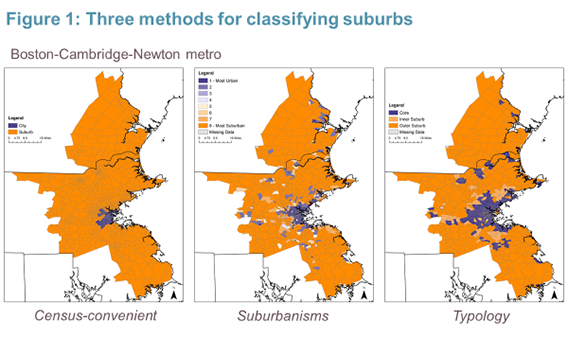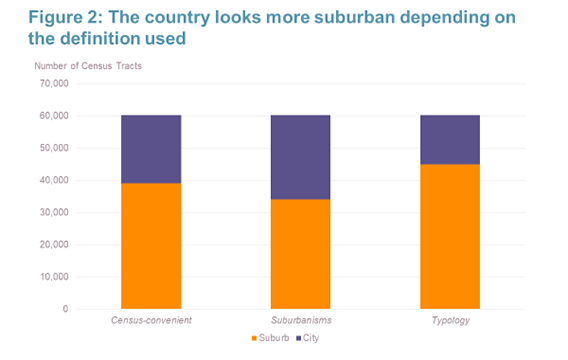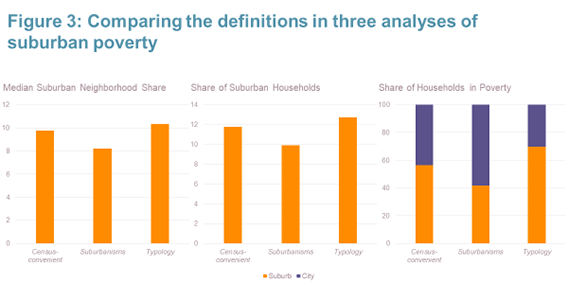The Implications of Different Suburban Definitions
Riverside is a low-density neighborhood in the city of Columbus, Ohio that has a distinctly suburban feel. About three-quarters of the housing units are owner-occupied, single-family homes, almost all were built after 1970, and about 90 percent of residents commute to work by car.
How would you characterize such a place? Since it’s part of Columbus (which is the largest city in the Columbus MSA), is it urban? Or does its physical character and the nature of its residents make it a suburb?
Researchers regularly confront questions like this when they study neighborhoods, in large measure because the U.S. Census’s 15-chapter long compendium of geographic terms and concepts does not include any definition of “suburb” or “suburban.” As a result, in recent years, researchers have created their own methodologies for defining suburban neighborhoods.
In our new working paper (which will be featured in a lunchtime Research Seminar this Friday, February 22), Shannon Rieger and I explore varying approaches to defining suburbs and investigate whether (and how) different definitions might affect researchers’ findings about the characteristics of America’s suburbs. We began by reviewing different approaches, which we found fell into three broad areas that we called the census-convenient, suburbanisms, and typology approaches. We then chose one specific method to operationalize each of these approaches and applied these classifications to nearly 61,000 census tracts in 382 metropolitan areas in the United States.
- The census-convenient definition, which is based on work by Elizabeth Kneebone and Carey Anne Nadeau, is an easily-developed approach that relies on metro names and place boundaries. Tracts are classified as urban if they are located either in the first named place of a metropolitan area’s title (such as Columbus) or are in other named places with populations over 100,000. In this approach, all other tracts within the metropolitan area would be considered suburban.
- The suburbanisms definition, which is based on work by Markus Moos and Pablo Mendez, focuses on suburban ways of life by comparing the tract-level shares of single-family homes, homeowners, and car commuters with the metro-level shares. Tracts with below-average rates for at least two of the variables are considered urban. Those where two or more rates are above metro-area levels are considered suburban. Despite being suburban in feel, Columbus’s Riverside neighborhood has apartment complexes that push it into an urban category.
- The typology definition, which is based on work by Thomas Cooke and Sarah Marchant, focuses on suburbs’ physical character by examining tract-level data on population density, housing density, and the age of the housing stock. Tracts are considered urban if they have at least 200 to 400 pre-1940 housing units per square mile and more than 1,000 residents per square mile. Places that fall below these thresholds, such as Riverside, are considered suburban.
Not surprisingly, these definitions produce somewhat different results for any given metro area (Figure 1). Overall, under the census-convenient approach, about two-thirds of tracts were classified as suburban. The share dropped to 57 percent under the suburbanisms definition but increases to about three-quarters of all tracts under the typology approach (Figure 2). However, as shown in Figure 1, not all metro areas followed these overall patterns.
Despite their notable differences, there was some significant convergence among the definitions. Among those tracts defined as suburban under any of the definitions, 49 percent were suburban according to the other two definitions and another 30 percent were classified as suburbs under two of the three approaches. Just 21 percent were classified as suburban under only one of the three definitions.
We also assessed whether the different definitions produced substantial differences in key housing and demographic variables. We did so in three ways (Figure 3). The first analysis used median neighborhood characteristics. Across the definitions, we found only small differences in the median characteristics for nearly all metrics. For example, the median share of suburban households living below the poverty line only ranged from about 8 to 10 percent across definitions. The biggest difference was in the race/ethnicity of the householder, with suburban neighborhoods under the typology appearing much more diverse than suburbs under the other two definitions.
The second analysis, which considered the extent of a given characteristic within suburbs, showed slightly greater variation across the definitions. The range in the suburban poverty variable increased from just under 10 percent to over 12 percent. Unsurprisingly, measures of homeownership, single-family housing, and white householders in the suburbs were higher under the suburbanisms definition than under the census-convenient or typology definitions.
The third analysis, which examined the geographic split of a characteristic between city and suburban neighborhoods produced even more striking differences. For example, under the suburbanisms definition, 60 percent of the population lived in suburbs compared to 79 percent under the typology definition. The variation in population coverage leads to much wider discrepancies between the definitions on several other metrics. For example, the suburban share of households below the poverty line ranged from 42 percent in the suburbanisms definition to 70 percent under the typology approach.
These analyses show that researchers should be aware that the methods they choose for delineating suburban and urban areas within a metro can have substantial impacts on their findings. The findings also highlight the need for the Census Bureau to implement a standardized definition of suburbs. Doing so would give researchers and practitioners a starting point for identifying suburban neighborhoods and a touchstone that researchers could use when developing new classification methodologies. While a standardized definition might not be appropriate for every study, it would at least increase our collective understanding of how suburban studies relate to each other.
This Friday, February 22, Whitney will present these findings in a lunchtime Research Seminar at the Joint Center for Housing Studies, which will also be livestreamed on Twitter.




